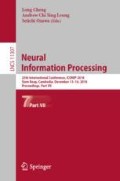Abstract
In order to take into account evading mechanism and make more realistic simulation results, we propose a data-driven and collision-free hybrid crowd simulation model in this paper. The first part of the model is a data-driven process in which we introduce an algorithm called MS-ISODATA (Main Streams Iterative Self-organizing Data Analysis) to learn motion patterns from real scenarios. The second part introduces an agent-based collision-free mechanism in which a steering approach is improved and this part uses the output from the first part to guide its agents. The hybrid simulation model we propose can reproduce simulated crowds with motion features of real scenarios, and it also enables agents in simulation evade from mutual collisions. The simulation results show that the hybrid crowd simulation model mimics the desired crowd dynamics well. According to a collectiveness measurement, the simulation results and real scenarios are very close. Meanwhile, it reduces the number of virtual crowd collisions and makes the movement of the crowd more effective.
Access this chapter
Tax calculation will be finalised at checkout
Purchases are for personal use only
References
Chan, A.B., Liang, Z.S.J., Vasconcelos, N.: Privacy preserving crowd monitoring: counting people without people models or tracking. In: 26th IEEE Conference on Computer Vision and Pattern Recognition, pp. 1–7. IEEE Press, Anchorage (2008)
Huang, X., Wang, W., Shen, G., Feng, X., Kong, X.: Crowd activity classification using category constrained correlated topic model. KSII Trans. Internet Inf. Syst. 10, 5530–5546 (2016)
Bera, A., Manocha, D.: Realtime multilevel crowd tracking using reciprocal velocity obstacles. In: 22nd IEEE International Conference on Pattern Recognition, pp. 4164–4169. IEEE Press, Stockholm (2014)
Cui, J., Liu, W., Xing, W.: Crowd behaviors analysis and abnormal detection based on surveillance data. J. Vis. Lang. Comput. 25(6), 628–636 (2014)
Shao, J., Loy, C.C., Wang, X.: Learning scene-independent group descriptors for crowd understanding. IEEE Trans. Circ. Syst. Video Technol. 27(6), 1290–1303 (2017)
Martinez-Gil, F., Lozano, M., Fernández, F.: Emergent behaviors and scalability for multi-agent reinforcement learning-based pedestrian models. Simu. Model. Pract. Theory 74, 117–133 (2017)
Junior, J.C.S.J., Musse, S.R., Jung, C.R.: Crowd analysis using computer vision techniques. IEEE Sig. Process. Mag. 27(5), 66–77 (2010)
Reynolds, C.W.: Flocks, herds and schools: a distributed behavioral model. ACM SIGGRAPH Comput. Graph. 21(4), 25–34 (1987)
Helbing, D., Molnar, P.: Social force model for pedestrian dynamics. Phys. Rev. E 51(5), 4282 (1995)
Helbing, D., Farkas, I., Vicsek, T.: Simulating dynamical features of escape panic. Nature 407(6803), 487–490 (2000)
Duan, Z., Gu, X.: Animal group behavioral model with evasion mechanism. In: IEEE International Joint Conference on Neural Networks, pp. 1167–1172. IEEE Press, Beijing (2014)
Lerner, A., Chrysanthou, Y., Lischinski, D.: Crowds by example. Comput. Graph. Forum 26(3), 655–664 (2007)
Lee, K.H., Choi, M.G., Hong, Q., Lee, J.: Group behavior from video: a data-driven approach to crowd simulation. In: Proceedings of the 2007 ACM SIGGRAPH/Eurographics Symposium on Computer Animation, pp. 109–118. ACM Press, San Diego (2007)
Karamouzas, I., Skinner, B., Guy, S.J.: Universal power law governing pedestrian interactions. Phys. Rev. Lett. 113(23), 238701 (2014)
Benfold, B., Reid, I.: Stable multi-target tracking in real-time surveillance video. In: 29th IEEE Conference on Computer Vision and Pattern Recognition, pp. 3457–3464. IEEE Press, Colorado (2011)
Berclaz, J., Fleuret, F., Fua, P.: Multiple object tracking using flow linear programming. In: 12th IEEE International Workshop on Performance Evaluation of Tracking and Surveillance (PETS-Winter), pp. 1–8. IEEE Press, Snowbird (2009)
Tomasi, C.: Detection and tracking of point features. Technical report 91(21), 9795–9802 (1991)
Zhou, B., Tang, X., Wang, X.: Measuring crowd collectiveness. In: 31st IEEE Conference on Computer Vision and Pattern Recognition, pp. 3049–3056. IEEE Press, Portland (2013)
Pellegrini, S., Ess, A., Schindler, K., Van Gool, L.: You’ll never walk alone: Modeling social behavior for multi-target tracking. In: 12th IEEE International Conference on Computer Vision, pp. 261–268. Kyoto (2009)
Ball, G.H., Hall, D.J.: ISODATA, a novel method of data analysis and pattern classification. Stanford Research Institute, AD-699616 (1965)
Ondřej, J., Pettré, J., Olivier, A.H., Donikian, S.: A synthetic-vision based steering approach for crowd simulation. ACM Trans. Graph. (TOG) 29(4), 123 (2010)
Zhou, B., Wang, X., Tang, X.: Understanding collective crowd behaviors: learning a mixture model of dynamic pedestrian-agents. In: 30th IEEE Conference on Computer Vision and Pattern Recognition, pp. 2871–2878. IEEE Press, Providence (2012)
Guy, S., Van Den Berg, J., Liu, W., Lau, R., Lin, M.C.: A statistical similarity measure for aggregate crowd dynamics. ACM Trans. Graph. (TOG) 31(6), 190 (2012)
Wong, S.M., Yao, Y.Y.: A statistical similarity measure. In: Proceedings of the 10th Annual International ACM SIGIR Conference on Research and Development in Information Retrieval, pp. 3–12. ACM Press, New Orleans (1987)
Acknowledgments
This work is supported by national natural science foundation of China under grants 61771145 and 61371148.
Author information
Authors and Affiliations
Corresponding author
Editor information
Editors and Affiliations
Rights and permissions
Copyright information
© 2018 Springer Nature Switzerland AG
About this paper
Cite this paper
Cheng, Q., Duan, Z., Gu, X. (2018). Data-Driven and Collision-Free Hybrid Crowd Simulation Model for Real Scenario. In: Cheng, L., Leung, A., Ozawa, S. (eds) Neural Information Processing. ICONIP 2018. Lecture Notes in Computer Science(), vol 11307. Springer, Cham. https://doi.org/10.1007/978-3-030-04239-4_6
Download citation
DOI: https://doi.org/10.1007/978-3-030-04239-4_6
Published:
Publisher Name: Springer, Cham
Print ISBN: 978-3-030-04238-7
Online ISBN: 978-3-030-04239-4
eBook Packages: Computer ScienceComputer Science (R0)

